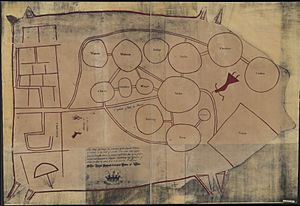Wateree people facts for kids
| Total population | |
|---|---|
| extinct | |
| Regions with significant populations | |
| Languages | |
| unknown, possibly an Eastern Siouan language | |
| Religion | |
| Native American religion | |
| Related ethnic groups | |
| probably Catawba people |
The Wateree were a group of Native American people. They lived in the Carolinas, which is now part of the United States. They likely spoke a language related to the Siouan and Catawba language families.
Spanish explorers first met the Wateree in 1567 in Western North Carolina. By 1700, they had moved southeast to what is now South Carolina. English settlers found them living along the Wateree River, near where Camden, South Carolina is today.
The Wateree were once a large tribe. However, many of them died during the Yamasee War in 1715. By the end of the 1700s, the Wateree no longer existed as a separate tribe.
Contents
Understanding the Wateree Name
The name Wateree might come from the Catawba word wateran. This word means "to float on the water." Another idea is that it comes from yeh is-WAH h'reh. This phrase means "people of the [Wateree] river."
Wateree History: 1500s and 1600s
Spanish explorers first wrote about the Wateree in 1567. Captain Juan Pardo's scribe, Juan de la Bandera, recorded them. He called them the Guatari in his travel journal. This was also the name of their village.
Bandera wrote that two female chiefs led the Guatari people. The Spanish noted that Guatari was far from the coast. Experts believe this village was in what is now Rowan County, North Carolina.
In 1670, English settlers and explorers also mentioned the Wateree. They said the Wateree lived near the upper Yadkin River. This was northwest of where they later settled.
Wateree History: The 1700s
By 1700, the Wateree had moved south. John Lawson's expedition saw them living along the Wateree River. This area is near modern-day Camden, South Carolina. The British noticed that Wateree chiefs had more power than leaders of other tribes nearby.
The Wateree were a strong tribe, but their power weakened during the Yamasee War of 1715. This war was against the Carolina colonists. The Wateree then joined a group of tribes led by the Catawba. The Catawba tribe took in people from many other tribes. This happened because of fighting and problems between tribes.
One trader, James Adair, heard many different languages spoken by Native Americans. He traded in the Catawba River area between 1736 and 1743. He heard over twenty languages, including Wateree. If a group was large enough, they often made their own village. They also chose their own leaders.
The Wateree seemed to keep their culture and language until at least 1744. A record shows that Wateree people sold land to a white man. The Wateree tribe, as a distinct group, no longer exists. However, some people in the modern-day Catawba tribe may be descendants of the Wateree.
See also
 In Spanish: Wateree para niños
In Spanish: Wateree para niños


